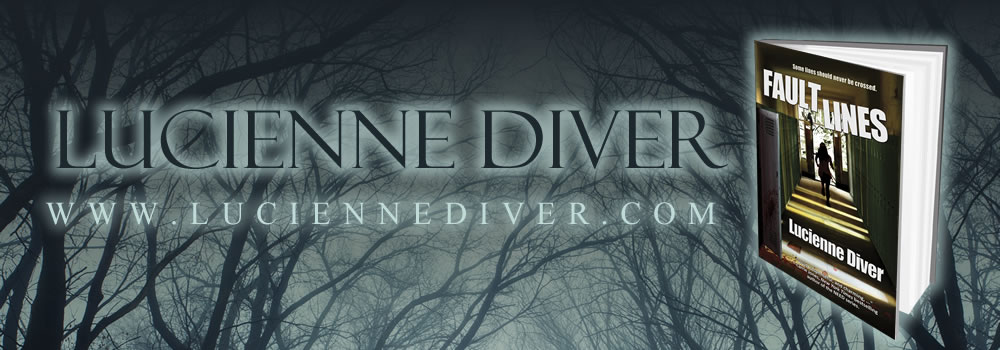This is a different kind of book for those who read Diver’s novels. This is a book that comes from the heart, from the headlines and with the hope that girls learn to speak up for themselves, be heard, be seen, and be proud.
Usually my novels start with a character talking in my head and in order to keep them from chattering aimlessly, I have to build a story line around them. Not so with Faultlines. The idea for Faultlines came up in a most unusual way—I was doing a talk at a school and I didn’t want to use my story lines from the Vamped novels to illustrate plot development, conflict, escalation, climax and denouement. I wanted something more mainstream and accessible to everyone. To my surprise, I came up with something on the fly that I called The Notebook. A girl is dead and her notebook, her journal, contains secrets that keep popping up, causing trouble for people that builds toward a dangerous crescendo.
That was all I had at that point, but I thought hey, that’s pretty good. I should mark that down and use it some time. But I was in the midst of deadlines for the Vamped series and then my agent sold the Latter-Day Olympians series, and so the concept took up space in my back brain, never leaving me but not allowed to come to the fore…until it wouldn’t be denied.
I was at a house party, of all places, surrounded by people, and yet I felt the need to sneak away, grab my notebook and pen and start writing. Now, I said my novels usually begin with characters. I like writing strong women, and in both the aforementioned series, my protagonists are bold and snarky, always apt to run headlong into a fight. I have a character like that in the novel that came to be called Faultlines as well. The problem is, she’s dead.
Six months before the start of the novel, Lisa stopped fighting. She pushed everyone away, started dressing to be overlooked rather than looked over, and withdrew into herself. My heroine, Vanessa, was her best friend. The sensible one. The one who did what she was supposed to. But now, Lisa is gone and all Vanessa wants to do is make a scene—yell and scream and demand that someone pay attention, because Lisa could not possibly have killed herself. She couldn’t.
Staying quiet, being good hasn’t worked out very well for her. She feels like she failed her friend and that maybe it’s time to try something different. There are so many points I want to make here that it would probably take a series of blogs, so I’ll try to stick to two. Authors are always doing that—plots can go off in a million different directions, and we have to pick and choose what will make the novel strongest. So, here’s what I most want to say.
I think that young women, in particular, are often taught to be proper. Not to cause a fuss, not to create a stir or draw attention. There’s so much text and subtext out there that implies that if girls or women behave or dress in a way that gets them noticed, they’ve invited harassment, bullying and other grief. And sadly, that’s exactly what a woman often gets for speaking out. Some characters in Faultlines decide not to speak out for this very reason. The problem is, this is how the bad guys win. This is how they get to move on and hurt someone else. If all of the good people spoke up, we could shout down the bad, drown out their voices. We could expose predators to the light to wither rather than thrive in secrets and shadows.
So easy to say. So difficult to do. Trust me, I know. I kick myself for every time I’ve stayed silent, and I’ve smarted from the wounds of every time I’ve spoken up.
Vanessa gets jump-started into various realizations because of Lisa’s death, because here’s another thing I want to say—people will often step up to fill a void. When Vanessa and Lisa were close, Lisa was the ringleader. Vanessa could be daring in her wake. But without Lisa, she has to push herself. She starts by asking herself What Would Lisa Do? but she comes up with her own answers as well.
Do about what? you might ask. Well, Faultlines is about a lot of things, but particularly finding fault and assigning blame. Vanessa blames herself for not being stronger, for letting Lisa push her away. She has no idea what led Lisa to end her life, but together with the boy she secretly loves who was Lisa’s almost-boyfriend and so eternally off limits, she decides she needs to find out. Maybe if she can discover what happened to Lisa, she can start to accept her death. Only, while she’s investigating, someone jumps ahead, attacking people they perceive hurt Lisa. As the former best friend, Vanessa is blamed. Absent any evidence at all, people retaliate against her, starting a circle of escalating violence. It has to stop. Vanessa seems the only one inclined to stop it. And so she must step up.
Faultlines is a novel of so many things, all of them very close to my heart. All of them complex and difficult. I hope I’ve done them justice. I hope I’ve done Vanessa justice the way that she plans to do for Lisa. And I hope that those of you who read Faultlines will let me know and that you’ll reach out if you see yourselves or someone you know in the novel—not necessarily to me, although I’m here if you need me, but to someone trained to help. No one should suffer in silence.


